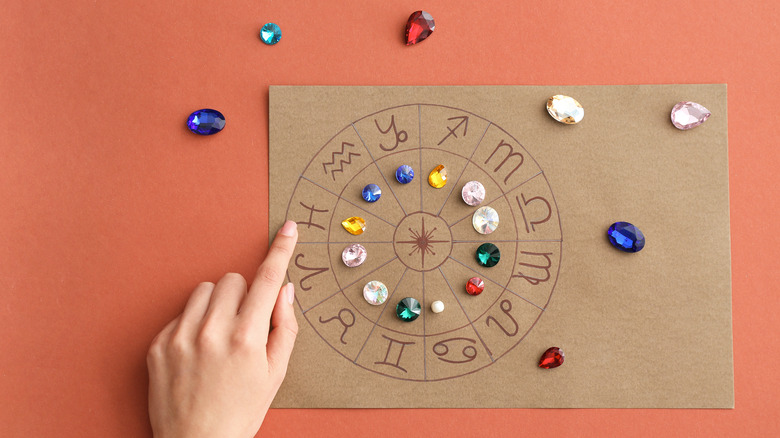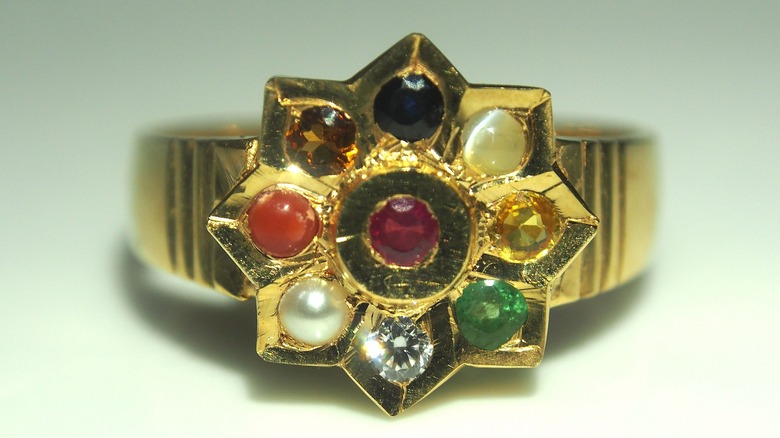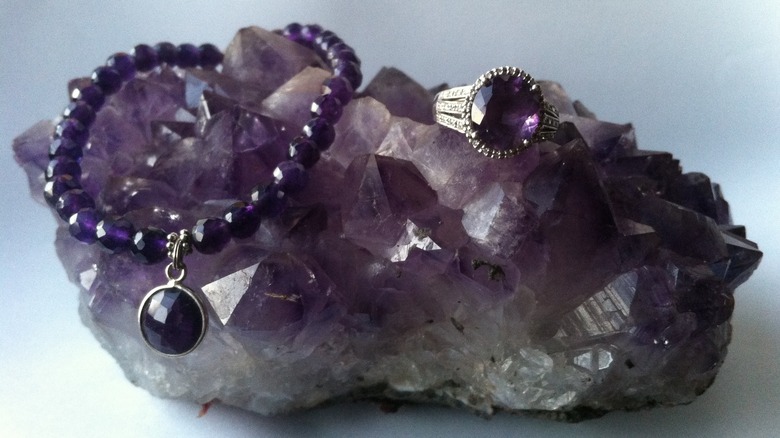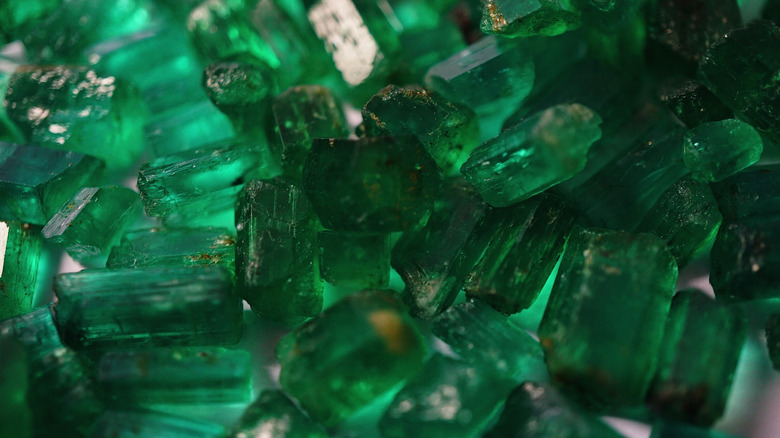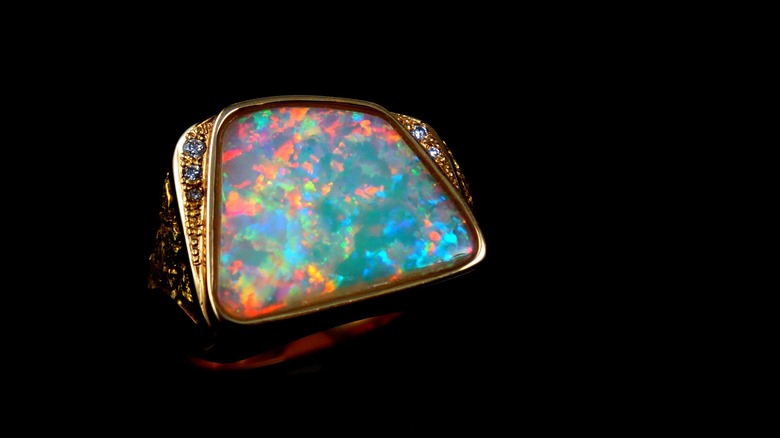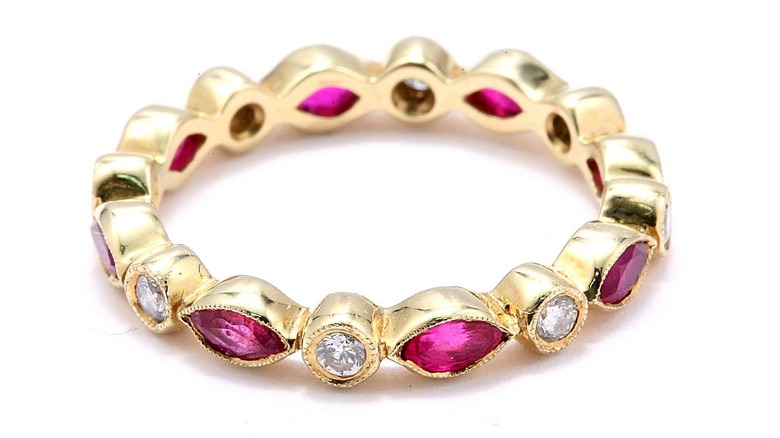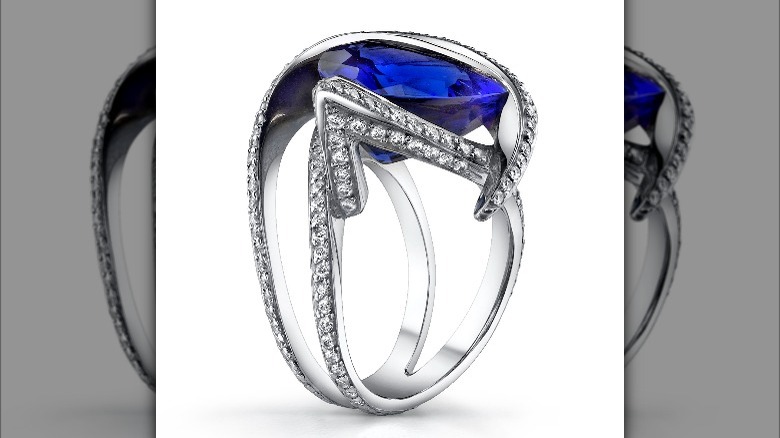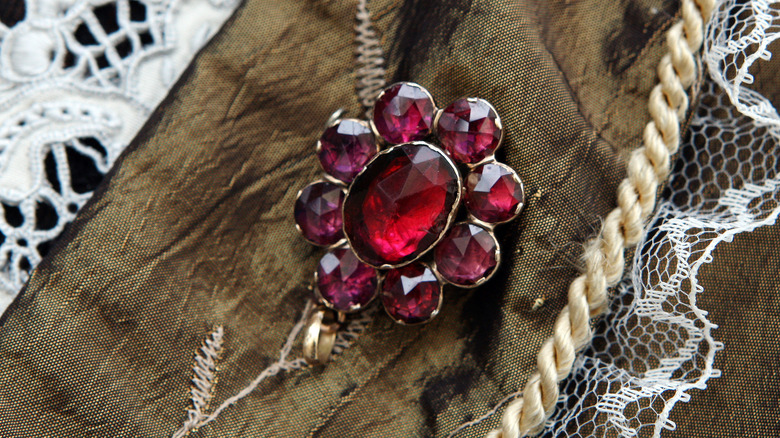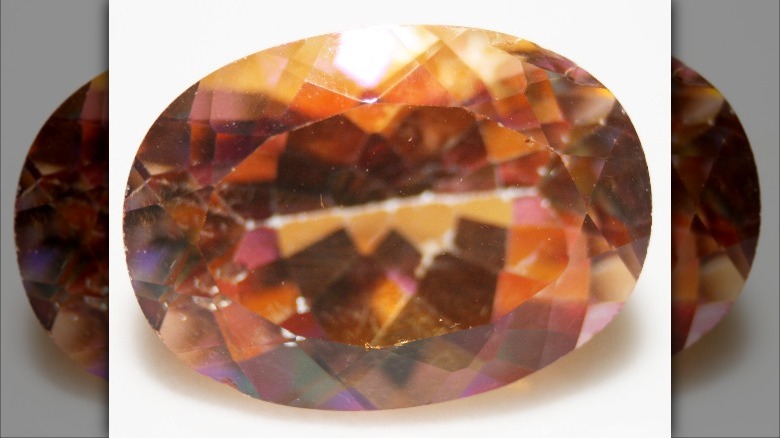The Untold Truth Of Birthstones
If jewelry and gems are a little intimidating, then there's a pretty easy entry point for just about anyone: birthstones. A casual search will quickly land you on a list of each month's unique stone (or, in some cases, multiple stones). If you're looking for a gift to give a special someone in your life, then that's an easy solution. But where did the idea of birthstones come from, anyway? And how can you be so sure that this list is right?
Turns out there is some historical truth to the concept, but things in the birthstone world can get complicated fast. Depending on your birth month, you may have only one gemstone to pick or a relatively wide variety. That list may also depend on which gem association or tradition provided it. According to the American Gem Society, most standard birthstone lists reserve garnet for January, amethyst for February, followed by bloodstone or aquamarine for March. April and May have diamond and emerald respectively, while June babies can pick alexandrite or pearl.
July has ruby and August is represented by peridot, spinel, or sardonyx. September has sapphire. October births merit either tourmaline or opal, while November gets citrine or topaz. December is the most chock-full birthstone month, with a slate of blue-hued choices including blue zircon, blue topaz, tanzanite, lapis lazuli, and turquoise. This may all seem like a lot, but there's even more to learn. This is the untold truth of birthstones.
The concept of birthstones is linked to the Bible
The origin of birthstones is pretty debatable, but one of the earliest possible genesis points for this idea may go back thousands of years to Biblical times. That's because some link the concept of birthstones to the breastplate worn by early Israelite priest Aaron, who's mentioned in the Old Testament Book of Exodus (via Forbes). His bejeweled chest piece is described in elaborate detail in Exodus 28:15-21, which reads a bit like assembly instructions and includes not just gemstones, but gold and richly colored textiles. "There are to be twelve stones, one for each of the names of the sons of Israel," states the text.
Per the International Gem Society, they include a row of carnelian, chrysolite, and emerald; another of turquoise, sapphire, and amethyst; and one of jacinth (potentially sapphire), agate, and crystal (quartz). It was finished off with a fourth row of beryl, lapis lazuli, and jasper. The chrysolite may have been what we now understand to be either chrysoberyl or the green-hued peridot (now one of August's birthstones). And sapphire could well have been the similarly blue-tinged lapis lazuli, too.
Some have also linked these jewels to different times of year. The birthstone link was explored by either first-century historian Flavius Josephus (per Forbes) or much later in the 20th century. "Gems and Gemstones" argues that George Frederick Kunz made the connection between Aaron's breastplate and "natal stones" in his 1913 book, "The Curious Lore of Precious Stones."
Hinduism may also play into birthstone lore
Beliefs that play into our modern understanding of birthstones aren't restricted to Biblical or European contexts. In fact, some early Hindu religious documents link religious belief and gemstones, including the very idea that some stones are assigned to individuals based on the time of their birth. According to the International Gem Society, the fifth-century Ratna Pariksha text specifically links various gems with different individuals and categories, including gods, specific days of the week, and planetary bodies.
Nine specific gems, known collectively as the Navaratna, are especially interesting in the context of Vedic religious belief. "Ancient Astrological Gemstones and Talismans" maintains that these traditionally include ruby, pearl, coral, emerald, yellow-hued sapphire, diamond, blue sapphire, hessonite (a type of garnet), and cat's eye (which can be a variety of gems but is often chrysoberyl, per Britannica). Associated with planets, these gems can then be linked to one's astrological chart in the Vedic tradition and, therefore, produce an individual's uniquely powerful stone. According to lore, wearing the correct gem can put one in harmony with the universe and potentially even repel the ill effects of certain planets or other cosmic forces while looking pretty good, too.
There are many folk traditions associated with birthstones
Part of modern gemstone lore is linked to an 1870 poem, according to "Gems and Gem Minerals." But individual stones are said to have unique properties beyond a few lines of rhyming text. Diamonds, April's birthstone, are believed to embody a bevy of attributes including power, innocence, and long life, per Vogue. The birthstone for July, ruby, was so beloved in ancient times that it's known in Sanskrit as ratnaraj, or "king of precious stones," and gets multiple mentions in the Bible for its links to wisdom and vital life forces. Both of March's stones, aquamarine and bloodstone, are said to bring spiritual clarity and bodily health (via GIA).
Not to be left out, emeralds (May's birthstone) are also widely valued and were supposedly gifted to the Biblical king Solomon as part of a set of jewels that gave the earthly ruler power over pretty much everything, according to the Gemological Institute of America. February's purple-hued amethyst also has plenty of mystical stories attached to it and supposedly helps ward off drunkenness — though testing it too thoroughly on that count isn't recommended (via GIA).
Generally associated with November, topaz has an especially ancient history. The people of ancient Greece linked it to physical strength, while Renaissance Europeans thought that it had mystical counter-magic properties (via Gemological Institute of America). Sapphires, meanwhile, are linked to celestial imagery and the clergy because of their pure sky-blue color, says the GIA.
There may be an uncovered segment of birthstone history
Clearly, tracking down definitive sources for the backstory of birthstones is pretty tricky. People have been mining shiny rocks out of the earth for thousands of years, after all, giving our species plenty of time to come up with stories and associations for these sparklers (without providing proper documentation). But there may be an often-ignored link here: early modern Europe.
According to "Gems and Gemstones: Timeless Natural Beauty of the Mineral World," writer and gemologist George Frederick Kunz claimed that the link between birth months and gemstones came about in 18th-century Poland. However, perhaps because sourcing was a bit different in 1913 when he published his volume, Kunz didn't provide any clear sources for his claim.
Still, Jewish religious traditions in the region may hint at a basis in reality. There is, of course, that mention in Exodus of Aaron's priestly bejeweled breastplate. And it is true, as "Gems and Gemstones" notes, that there was a large population of Jewish people living in Poland after migrating there throughout the 18th century. Later, in the 19th and early-20th centuries, many of these people then moved to the United States. Shortly thereafter, the contemporary idea of birthstones, especially as it was formed by the gem and jewelry industry, began to form. It's a circumstantial link, to be sure, but one that may help explain how migration, Hebrew scriptures, and Jewish culture could have brought the idea of birthstones to America.
Birthstones also have a modern component
Though there's a lot of talk about the supposedly ancient origins of birthstones, from Hindu religious texts to Hebrew traditions, the full truth of birthstones as you've encountered them is pretty different. In reality, the concept has been filtered down through the centuries and, for many, has come to us courtesy of a boardroom meeting somewhere.
As "The Curious Lore of Precious Stones" reports, the National Association of Jewelers first met in 1912 to determine a standardized list of birthstones. While there were already various traditional associations between given gems and birth dates, this appears to be the first time a trade group sat down to agree upon a particular list.
Since then, the list has been revamped a few more times, including in 1952 when alexandrite, citrine, tourmaline, and zircon were added, per National Jeweler. In 2002, another update included tanzanite in the already thoroughly-packed December list of birthstones. The latest update came as late as 2016. That's when both the Jewelers of America and the American Gem Trade Association agreed to add typically reddish spinel as an August birthstone. Though August already had the green peridot on its roster, these professional associations thought the summer month (and perhaps spinel sales, while they were at it) could use a bit of a boost.
Some believe that wearing the wrong stone can be unlucky
Let's say that you're an August arrival, but maybe you're not exactly a fan of August's peridot. Or it could be that none of December's bevy of birthstones really appeals to you, even though you can now pick from blue zircon, blue topaz, tanzanite, turquoise, or lapis lazuli, depending on which list you consult (via International Gem Society).
You may cast your eye towards other people's birthstones, but beware. Some traditions maintain that stones like October's opal are only lucky for those born in the right month. Anyone else who disregards this lore may find themselves in trouble, as the stories claim. Opals seem to be the target for many of these stories, with their many different colors and complex interplay of light through the gem's silica-rich depths. However, "Gems and Gemstones" notes that it's also fairly fragile, and it could be that its tendency to ominously shatter led to its less-than-stellar reputation. Even Queen Victoria wasn't reportedly immune from its effects, as when a malfunctioning opal brooch supposedly threatened to reveal rather too much of her royal body at her coronation.
Then again, you may remain skeptical, especially if the opal's unique, shimmering look is especially beautiful in your eyes. Take heart, then. The University of Nebraska-Lincoln reports that this superstition may only go back as far as the 19th century and, in fact, may have been completely invented by novelist Sir Walter Scott in 1831.
Birthstones are strongly connected to marketing ploys
Many of us have to admit that there's something about all these birthstone lists that are a little, well, suspicious. There's quite a few of them, for one, and it may seem odd that a seemingly ancient tradition such as natal stones is subject to so many updates and modifications. And why do all of these different gemstone dealers, jewelry makers, and professional organizations feel like they have a say in the matter?
That's because much of modern birthstone lore is really part of a large marketing ploy that's pretty obviously meant to keep sales going in the gemstone and jewelry industry. "Jewels: A Secret History" argues that the early 1912 list assembled by the American National Association of Jewelers was predicated on the kinds of gems that the jewelers in question needed to sell. And "Gems and Gemstones" points out the difficult-to-ignore fact that these lists can and often do change when promising new stones hit the market, like tanzanite did in the early 2000s.
To this end, Britannica reports that modern lists have included cheaper and more available synthetic alternatives for the budget-minded consumer. Various groups have also made changes to the birthstone list to make them more attractive to male buyers — after all, why leave such a significant buyer group as half of the population out of their sights?
The man who helped popularize birthstones didn't like commercialization
Though the path to today's birthstone lists comes through a variety of cultures, people, and places, you can pin a lot of the credit on one man: George Frederick Kunz. According to Atlas Obscura, Kunz was the vice president of jewelry giant Tiffany & Co. in 1913, when he wrote "The Curious Lore of Precious Stones," which had been preceded by the 1909 volume, "Natal Stones: Sentiments and Superstitions Associated with Precious Stones."
Though Kunz clearly had some interest in marketing and selling gemstones to the public, his motivations behind his writings were more complex. In reality, Kunz believed that "natal stones" should be kept special and separate from crass marketing ploys. In "The Curious Lore of Precious Stones," he wrote that the "spirit of commercialism" could forever alter the unique lore of birthstones. If everyone dove headfirst into the capitalistic side of things, he said, "there is grave danger that the only true incentive to acquire birth-stones will be weakened."
What's more, he said this sort of drive would cheapen not only the industry but perhaps even the human spirit and its sense of sentiment. "Nothing is more likely to destroy it than the conviction that it is being constantly exploited for purposes of commercialism," he wrote.
Tanzanite is one of the newer birthstones
Reportedly uncovered in the 20th century, tanzanite is one of the newest gemstones out there, especially when it comes to birthstones. According to the story related by the Gemological Institute of America, the dark blue gem was first uncovered by a Masai man in 1967 Tanzania. After some mining and what was surely canny marketing, the new stone soon became popular, with Tiffany & Co. becoming its main distributor and plenty of marketing campaigns making it a popular pick (and, eventually, yet another December birthstone).
Yet, the story of tanzanite is a bit more complicated than all that. "Between the Plough and the Pick" notes that there's been some controversy over the tanzanite trade, with some linking it back to terrorist-funding activity, while others claim that this is only an attempt to discredit small-scale miners. It was all brought further into the light with the October 2002 announcement that the American Gem Trade Association had added tanzanite to the December birthstone list. Boosted by this new development, demand for the gem subsequently grew. A 2002 article from Professional Jeweler Magazine claimed that it was such a helpful move that tanzanite quickly moved into second-place in popularity in the United States, outranked only by sapphires.
Garnet has a long history
As one of the few birthstones to remain stable throughout the many lists that have been issued throughout the years, January's deep red garnet gem has a rich scientific and cultural background. And that background reaches pretty far into the past, considering that it's featured in ancient and modern jewelry, according to the Gemological Institute of America. Garnets have been found in ancient Egyptian and Roman jewelry and appear to have been popular amongst the showy upper-class folks of medieval and Victorian-era Europe. One particularly spectacular piece is a hair comb donated to the Smithsonian in 1937, which is fairly encrusted with the red gems, including an especially large one in the center.
Those classic red garnets are actually just one variety of the gemstone and are known more specifically as pyrope; other types of garnet can be almost purple, pink, yellow, brown, green, orange, and even clear (via University of Waterloo). As for the less scientific properties of garnet, the Gemological Institute of America notes that some believed that garnets would clear one's mind, banish bad thoughts, and even reduce inflammation — though modern medical doctors will probably still cast a skeptical eye over many of these claims.
That November birthstone may not be strictly real
Topaz, one of the most popular birthstones for November, is more difficult to classify than you might think. It's easy to get confused by the color, and some people can even mistake common rocks or a synthetic stone for the more valuable real-deal mineral. Written in 1970, an article in Rocks & Minerals even went so far as to argue that professional jewelers might not be totally on top of the distinctions and could be selling a more mundane golden variety of quartz. It doesn't help that, as the International Gem Society notes, pre-20th-century sources named just about any semi-clear yellow, brown, or orange gems "topaz."
More recent dealers and gemologists might take exception to this and could well argue that they know the difference between plain old quartz and a truly brilliant golden-brown topaz. Still, it doesn't hurt to know about all the different ways that topaz can present itself.
According to the Gemological Institute of America, genuine topaz was once believed to have magical properties, or at least to ward off the effects of ill-intentioned spells while also (depending on who you asked, and when you asked them) lending extra strength, calmness, smarts, and beauty to the wearer. And as for those colors, there are quite a few that all still qualify as topaz, from the classic yellow-orange to pink, to purple, to blue. Perhaps for some, it's easier to switch to November's other birthstone, the less confusing citrine.
One of June's birthstones has a long history
Moonstones, one of three generally accepted birthstones for June, were reportedly believed by some ancient Hindu people to be made from moonlight, per the GIA. It was also a popular stone in both ancient Roman adornments (via the American Gem Society) and much later works by 20th-century Art Nouveau jewelers. According to the 1903 "Encyclopædia of Superstitions, Folklore, and the Occult Sciences of the World," this gem also has a few occult associations and was reportedly linked to the success of Frances Hodgson Burnett, the British writer who would eventually become famous for her novels "The Secret Garden” and "A Little Princess." The moonstone is also the state gem of Florida, thanks to its tangential connection with the Apollo space program. Never mind that moonstone is not found naturally in Florida (or on the moon, for that matter).
If the historical and mystical pedigree of moonstone still isn't your bag, then rest assured that June has at least two other birthstones, depending on the list you consult. According to the American Gem Society, those born in June can also pick pearl or alexandrite as their birthstone of choice.
